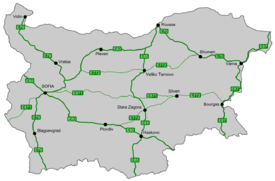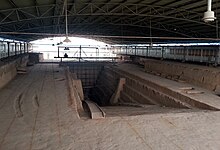사이클로프로페늄 이온
Cyclopropenium ion시클로프로페늄 이온은 CH라는
3+
3 공식을 가진 양이온이다.그것은 향기로운 양이온의 가장 작은 예로 관심을 끌었다.그것의 염분은 격리되었고, 많은 파생상품들이 X선 결정술로 특징지어졌다.[1]양이온과 몇 가지 간단한 파생상품은 토성의 위성 타이탄 대기에서 확인되었다.[2]
본딩
2 two 전자와 함께, 사이클로프로페늄 양이온 등급은 4n + 2 전자에 대한 후켈의 방향성 규칙을 준수한다. 이 경우 n = 0. 이러한 예측과 일관되게 CH33 코어는 평면이며 C–C 결합은 등가물이다.[[3]C3(SiMe3)]3+SbCl의−
6 cation의 경우 링 C–C 거리는 1.374(2) ~ 1.392(2) å이다.
합성
많은 사이클로프로페닐 양이온의 염분이 특징지어졌다.그들의 안정성은 대체물들의 강직하고 귀납적인 효과에 따라 달라진다.
트리페닐사이클로프로페늄의 염분은 1957년 로널드 브레슬로에 의해 처음 보고되었다.소금은 디페닐아세틸렌을 사용한 페닐디아조아세토나이트릴의 반응을 시작으로 두 단계로 나누어 1,2,3 트리페닐-2-사이클로프로펜 니트릴을 산출했다.붕소 3불화합물로 처리 [CPH33]BF4.[4][5][6]
모계양식인 [CH33]+는 1970년에 헥사클로로안티몬산염(SbCl−
6)으로 보고되었다.[7]-20 °C에서 무한정 안정적이다.
트리클로로클로프로페늄염은 테트라클로클로프로펜에서 염화물 추상화에 의해 생성된다.[8]
- C3Cl4 + AlCl3 → [C3Cl3]+AlCl−
4
테트라클로로클로프로펜은 트리스(테르트-부틸디메틸릴)사이클로프로펜으로 변환할 수 있다.니트로소늄 테트라플루오보트가 함유된 하이드라이드 추상화는 트리실릴 대체 사이클로프로페늄 양이온을 산출한다.[9]
아미노 대체 시클로프로페늄 염은 특히 안정적이다.[10][11]칼리센은 사이클로펜타디엔아이드와 연결된 사이클로프로페니움이 특징인 특이한 파생물이다.
반응
유기 화학
시클로프로페늄 에스테르의 염화염은 카르복실산을 산염화물로 변환하는 데 디클로로클로프로펜을 사용하는 중간 물질이다.[12]
관련된 사이클로프로페늄 양이온들은 사이클로프로페논으로부터 1,1-디클로클로프로펜의 재생에서 생산된다.
시클로프로페늄 염소화물이 펩타이드 결합 형성에 적용되었다.[12]예를 들어, 아래 그림에서, 사이클로프로페늄 이온의 존재에서 보호되지 않은 아미노산과 보크 보호 아미노산을 반응시키면, 비보호 아미노산과의 핵포함 치환에 이어 염화산 형성을 통해 펩타이드 결합을 형성할 수 있다.
산염소화물을 경미하게 생성하는 이 방법은 알파-아미노산당을 연결하는데도 유용할 수 있다.[13]사이클로프로페늄 이온을 사용하여 변이성 탄소에서 염화물을 형성한 후, 이 화합물은 요오드화합물인 테트라부틸람모늄으로 요오드화된다.이 요오드는 이후 어떤 ROH 그룹에 의해서도 대체될 수 있어 당분의 알파 선택적 연동을 빨리 할 수 있다.
또한 일부 합성 루트는 시클로프로페늄 고리 개구부를 사용하여 아라이엘카르베네이션(Alilcarbene cation)을 산출한다.선형 열화 생산물은 핵소성 탄소 중심과 전기소성 탄소 중심 모두를 산출한다.[14]
유기농 화합물
많은 단지가 사이클로프로페늄 리간드로 알려져 있다.예로는 [M(CPH33)(PPH3)](2+M = Ni, Pd, Pt)와 Co(CPH33)(CO)가 있다.3그러한 화합물은 낮은 발렌타인 금속 복합체를 가진 사이클로프로페늄 염의 반응에 의해 준비된다.[15]
다전극(polyelectolytes)
대체 파생상품이 많이 알려져 있기 때문에, 사이클로프로페늄 염은 담수화, 연료전지 등의 기술과 관련된 다전극으로서 관심을 끌었다.트리스(다이얼킬아미노)사이클로프로페늄 염은 안정성이 높기 때문에 특히 평가되어 왔다.[16]
참고 항목
참조
- ^ Smith, Michael B.; March, Jerry (2007), Advanced Organic Chemistry: Reactions, Mechanisms, and Structure (6th ed.), New York: Wiley-Interscience, ISBN 978-0-471-72091-1
- ^ A.Aliab, C.퍼스파린이드, "Cyclopropenyl cation - 가장 단순한 Huckel의 방향 분자 - 그리고 타이탄의 상층 대기권에서의 순환 메틸 유도체", 행성 및 우주 과학, 2013년 10월, 96-13페이지. https://doi.org/10.1016/j.pss.2013.07.007
- ^ De Meijere, A.; Faber, D.; Noltemeyer, M.; Boese, R.; Haumann, T.; Muller, T.; Bendikov, M.; Matzner, E.; Apeloig, Y. (1996). "Tris(trimethylsilyl)cyclopropenylium Cation: The First X-ray Structure Analysis of an α-Silyl-Substituted Carbocation". J. Org. Chem. 61 (24): 8564. doi:10.1021/jo960478e.
- ^ Yadav, Arvind (2012). "Cyclopropenium Ion". Synlett. 23 (16): 2428–2429. doi:10.1055/s-0032-1317230.
- ^ Ronald Breslow (1957). "Synthesis of the s-Triphenylcyclopropenyl Cation". J. Am. Chem. Soc. 79 (19): 5318. doi:10.1021/ja01576a067.
- ^ Xu, Ruo; Breslow, Ronald (1997). "1,2,3-Triphenylcyclopropenium Bromide". Org. Synth. 74: 72. doi:10.15227/orgsyn.074.0072.
- ^ Breslow, R.; Groves, J. T. (1970). "Cyclopropenyl Cation. Synthesis and Characterization". J. Am. Chem. Soc. 92 (4): 984–987. doi:10.1021/ja00707a040.
- ^ Glück, C.; Poingée, V.; Schwager, H. (1987). "Improved Synthesis of 7,7-Difluorocyclopropabenzene". Synthesis. 1987 (3): 260–262. doi:10.1055/s-1987-27908.
- ^ Buchholz, Herwig; Surya Prakash, G. K.; Deffieux, Denis; Olah, George (1999). "Electrochemical preparation of tris(tert-butyldimethylsilyl)cyclopropene and its hydride abstraction to tris(tert-butyldimethylsilyl)cyclopropenium tetrafluoroborate" (PDF). Proc. Natl. Acad. Sci. 96 (18): 10003–10005. Bibcode:1999PNAS...9610003B. doi:10.1073/pnas.96.18.10003. PMC 17831. PMID 10468551.
- ^ Bandar, Jeffrey S.; Lambert, Tristan H. (2013). "Aminocyclopropenium ions: synthesis, properties, and applications". Synthesis. 45 (10): 2485–2498. doi:10.1055/s-0033-1338516.
- ^ Haley, Michael M.; Gilbertson, Robert D.; Weakley, Timothy J.D. (2000). "Preparation, X-ray Crystal Structures, and Reactivity of Alkynylcyclopropenylium Salts". Journal of Organic Chemistry. 65 (5): 1422–1430. doi:10.1021/jo9915372. PMID 10814104.
- ^ a b Hardee, David J.; Kovalchuke, Lyudmila; Lambert, Tristan H. (2010). "Nucleophilic Acyl Substitution via Aromatic Cation Activation of Carboxylic Acids: Rapid Generation of Acid Chlorides under Mild Conditions". Journal of the American Chemical Society. 132 (14): 5002–5003. doi:10.1021/ja101292a. PMID 20297823.
- ^ Nogueira, J. M.; Nguyến, S. H.; Bennett, C. S. (2011). "Cyclopropenium Cation Promoted Dehydrative Glycosylations Using 2-Deoxy- and 2,6-Dideoxy-Sugar Donors". Journal of the American Chemical Society. 13 (11): 2184–2187. doi:10.1021/ol200726v. PMID 21548642.
- ^ Yoshida, Zen'ichi; Yoneda, Shigeo; Hirai, Hideo (1981). "A Novel Synthesis of Pyrroles by the Reactions of Tris(alkylthio)cyclopropenium Salt with Amines". Heterocycles. 15 (2): 865. doi:10.3987/S-1981-02-0865.
- ^ Chiang, T.; Kerber, R. C.; Kimball, S. D.; Lauher, J. W. (1979). "(η3-Triphenylcyclopropenyl) Tricarbonylcobalt". Inorganic Chemistry. 18 (6): 1687–1691. doi:10.1021/ic50196a058.
- ^ Jiang, Yivan; Freyer, Jessica; Cotanda, Pepa; Brucks, Spencer; Killops, Kato; Bandar, Jeffrey; Torsitano, Christopher; Balsara, Nitash; Lambert, Tristan; Campos, Luis (2015). "The evolution of cyclopropenium ions into functional polyelectrolytes" (PDF). Nature Communications. 6 (1): 1–7. Bibcode:2015NatCo...6E5950J. doi:10.1038/ncomms6950. PMC 4354017. PMID 25575214.












